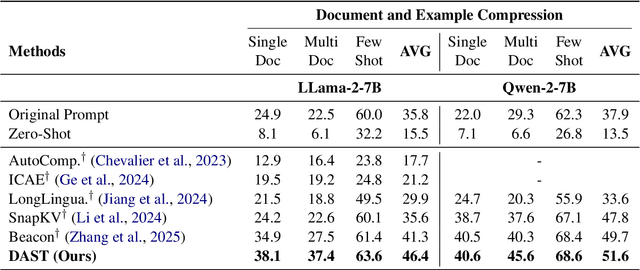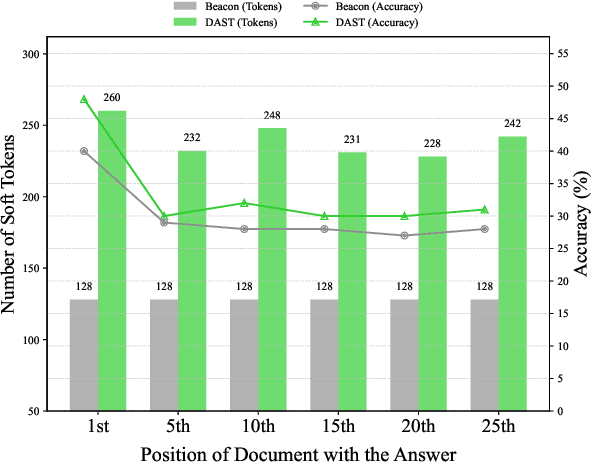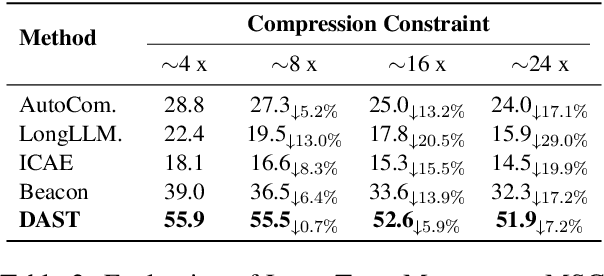Zishan Xu
Decoupling Continual Semantic Segmentation
Aug 07, 2025Abstract:Continual Semantic Segmentation (CSS) requires learning new classes without forgetting previously acquired knowledge, addressing the fundamental challenge of catastrophic forgetting in dense prediction tasks. However, existing CSS methods typically employ single-stage encoder-decoder architectures where segmentation masks and class labels are tightly coupled, leading to interference between old and new class learning and suboptimal retention-plasticity balance. We introduce DecoupleCSS, a novel two-stage framework for CSS. By decoupling class-aware detection from class-agnostic segmentation, DecoupleCSS enables more effective continual learning, preserving past knowledge while learning new classes. The first stage leverages pre-trained text and image encoders, adapted using LoRA, to encode class-specific information and generate location-aware prompts. In the second stage, the Segment Anything Model (SAM) is employed to produce precise segmentation masks, ensuring that segmentation knowledge is shared across both new and previous classes. This approach improves the balance between retention and adaptability in CSS, achieving state-of-the-art performance across a variety of challenging tasks. Our code is publicly available at: https://github.com/euyis1019/Decoupling-Continual-Semantic-Segmentation.
RAISE: Reinforenced Adaptive Instruction Selection For Large Language Models
Apr 09, 2025Abstract:In the instruction fine-tuning of large language models (LLMs), it has become a consensus that a few high-quality instructions are superior to a large number of low-quality instructions. At present, many instruction selection methods have been proposed, but most of these methods select instruction based on heuristic quality metrics, and only consider data selection before training. These designs lead to insufficient optimization of instruction fine-tuning, and fixed heuristic indicators are often difficult to optimize for specific tasks. So we designed a dynamic, task-objective-driven instruction selection framework RAISE(Reinforenced Adaptive Instruction SElection), which incorporates the entire instruction fine-tuning process into optimization, selecting instruction at each step based on the expected impact of instruction on model performance improvement. Our approach is well interpretable and has strong task-specific optimization capabilities. By modeling dynamic instruction selection as a sequential decision-making process, we use RL to train our selection strategy. Extensive experiments and result analysis prove the superiority of our method compared with other instruction selection methods. Notably, RAISE achieves superior performance by updating only 1\% of the training steps compared to full-data training, demonstrating its efficiency and effectiveness.
Revisiting Classification Taxonomy for Grammatical Errors
Feb 18, 2025Abstract:Grammatical error classification plays a crucial role in language learning systems, but existing classification taxonomies often lack rigorous validation, leading to inconsistencies and unreliable feedback. In this paper, we revisit previous classification taxonomies for grammatical errors by introducing a systematic and qualitative evaluation framework. Our approach examines four aspects of a taxonomy, i.e., exclusivity, coverage, balance, and usability. Then, we construct a high-quality grammatical error classification dataset annotated with multiple classification taxonomies and evaluate them grounding on our proposed evaluation framework. Our experiments reveal the drawbacks of existing taxonomies. Our contributions aim to improve the precision and effectiveness of error analysis, providing more understandable and actionable feedback for language learners.
DAST: Context-Aware Compression in LLMs via Dynamic Allocation of Soft Tokens
Feb 17, 2025



Abstract:Large Language Models (LLMs) face computational inefficiencies and redundant processing when handling long context inputs, prompting a focus on compression techniques. While existing semantic vector-based compression methods achieve promising performance, these methods fail to account for the intrinsic information density variations between context chunks, instead allocating soft tokens uniformly across context chunks. This uniform distribution inevitably diminishes allocation to information-critical regions. To address this, we propose Dynamic Allocation of Soft Tokens (DAST), a simple yet effective method that leverages the LLM's intrinsic understanding of contextual relevance to guide compression. DAST combines perplexity-based local information with attention-driven global information to dynamically allocate soft tokens to the informative-rich chunks, enabling effective, context-aware compression. Experimental results across multiple benchmarks demonstrate that DAST surpasses state-of-the-art methods.
IDGen: Item Discrimination Induced Prompt Generation for LLM Evaluation
Sep 27, 2024



Abstract:As Large Language Models (LLMs) grow increasingly adept at managing complex tasks, the evaluation set must keep pace with these advancements to ensure it remains sufficiently discriminative. Item Discrimination (ID) theory, which is widely used in educational assessment, measures the ability of individual test items to differentiate between high and low performers. Inspired by this theory, we propose an ID-induced prompt synthesis framework for evaluating LLMs to ensure the evaluation set can continually update and refine according to model abilities. Our data synthesis framework prioritizes both breadth and specificity. It can generate prompts that comprehensively evaluate the capabilities of LLMs while revealing meaningful performance differences between models, allowing for effective discrimination of their relative strengths and weaknesses across various tasks and domains. To produce high-quality data, we incorporate a self-correct mechanism into our generalization framework, and develop two models to predict prompt discrimination and difficulty score to facilitate our data synthesis framework, contributing valuable tools to evaluation data synthesis research. We apply our generated data to evaluate five SOTA models. Our data achieves an average score of 51.92, accompanied by a variance of 10.06. By contrast, previous works (i.e., SELF-INSTRUCT and WizardLM) obtain an average score exceeding 67, with a variance below 3.2. The results demonstrate that the data generated by our framework is more challenging and discriminative compared to previous works. We will release a dataset of over 3,000 carefully crafted prompts to facilitate evaluation research of LLMs.
EXCGEC: A Benchmark of Edit-wise Explainable Chinese Grammatical Error Correction
Jul 01, 2024



Abstract:Existing studies explore the explainability of Grammatical Error Correction (GEC) in a limited scenario, where they ignore the interaction between corrections and explanations. To bridge the gap, this paper introduces the task of EXplainable GEC (EXGEC), which focuses on the integral role of both correction and explanation tasks. To facilitate the task, we propose EXCGEC, a tailored benchmark for Chinese EXGEC consisting of 8,216 explanation-augmented samples featuring the design of hybrid edit-wise explanations. We benchmark several series of LLMs in multiple settings, covering post-explaining and pre-explaining. To promote the development of the task, we introduce a comprehensive suite of automatic metrics and conduct human evaluation experiments to demonstrate the human consistency of the automatic metrics for free-text explanations. All the codes and data will be released after the review.
CLEME2.0: Towards More Interpretable Evaluation by Disentangling Edits for Grammatical Error Correction
Jul 01, 2024Abstract:The paper focuses on improving the interpretability of Grammatical Error Correction (GEC) metrics, which receives little attention in previous studies. To bridge the gap, we propose CLEME2.0, a reference-based evaluation strategy that can describe four elementary dimensions of GEC systems, namely hit-correction, error-correction, under-correction, and over-correction. They collectively contribute to revealing the critical characteristics and locating drawbacks of GEC systems. Evaluating systems by Combining these dimensions leads to high human consistency over other reference-based and reference-less metrics. Extensive experiments on 2 human judgement datasets and 6 reference datasets demonstrate the effectiveness and robustness of our method. All the codes will be released after the peer review.
Enlighten-Your-Voice: When Multimodal Meets Zero-shot Low-light Image Enhancement
Dec 15, 2023Abstract:Low-light image enhancement is a crucial visual task, and many unsupervised methods tend to overlook the degradation of visible information in low-light scenes, which adversely affects the fusion of complementary information and hinders the generation of satisfactory results. To address this, our study introduces ``Enlighten-Your-Voice'', a multimodal enhancement framework that innovatively enriches user interaction through voice and textual commands. This approach does not merely signify a technical leap but also represents a paradigm shift in user engagement. Our model is equipped with a Dual Collaborative Attention Module (DCAM) that meticulously caters to distinct content and color discrepancies, thereby facilitating nuanced enhancements. Complementarily, we introduce a Semantic Feature Fusion (SFM) plug-and-play module that synergizes semantic context with low-light enhancement operations, sharpening the algorithm's efficacy. Crucially, ``Enlighten-Your-Voice'' showcases remarkable generalization in unsupervised zero-shot scenarios. The source code can be accessed from https://github.com/zhangbaijin/Enlighten-Your-Voice
Towards Real-World Writing Assistance: A Chinese Character Checking Benchmark with Faked and Misspelled Characters
Nov 19, 2023



Abstract:Writing assistance is an application closely related to human life and is also a fundamental Natural Language Processing (NLP) research field. Its aim is to improve the correctness and quality of input texts, with character checking being crucial in detecting and correcting wrong characters. From the perspective of the real world where handwriting occupies the vast majority, characters that humans get wrong include faked characters (i.e., untrue characters created due to writing errors) and misspelled characters (i.e., true characters used incorrectly due to spelling errors). However, existing datasets and related studies only focus on misspelled characters mainly caused by phonological or visual confusion, thereby ignoring faked characters which are more common and difficult. To break through this dilemma, we present Visual-C$^3$, a human-annotated Visual Chinese Character Checking dataset with faked and misspelled Chinese characters. To the best of our knowledge, Visual-C$^3$ is the first real-world visual and the largest human-crafted dataset for the Chinese character checking scenario. Additionally, we also propose and evaluate novel baseline methods on Visual-C$^3$. Extensive empirical results and analyses show that Visual-C$^3$ is high-quality yet challenging. The Visual-C$^3$ dataset and the baseline methods will be publicly available to facilitate further research in the community.
 Add to Chrome
Add to Chrome Add to Firefox
Add to Firefox Add to Edge
Add to Edge